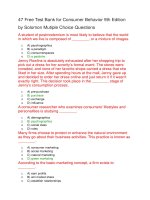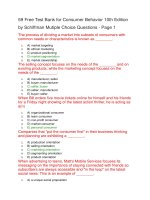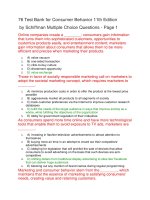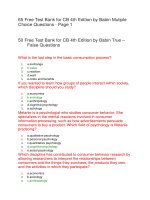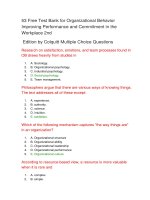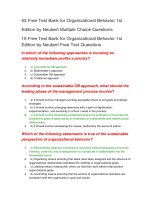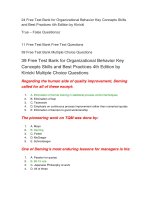103 test bank for organizational behavior 6th edition mcshane
Bạn đang xem bản rút gọn của tài liệu. Xem và tải ngay bản đầy đủ của tài liệu tại đây (114.92 KB, 19 trang )
103 Test Bank for Organizational Behavior 6th Edition
McShane
Multiple Choice Questions - Page 1
(p. 34) Which of the following directly influences an
employee's voluntary behavior and performance?
1.
2.
3.
4.
5.
A. Role perceptions
B. Moral intensity
C. Corporate social responsibility
D. Uncertainty avoidance
E. Income
(p. 41) An individual's personality:
1.
2.
3.
A. changes several times throughout the year.
B. is formed only from childhood socialization and the environment.
C. is less evident in situations where social norms, reward systems, and other
conditions constrain behavior.
4. D. does not provide an enduring pattern of processes.
5. E. is more prominent when rewards of behavior are substantial.
(p. 42) Eric is the advertising head of a firm. He is extremely
imaginative, creative, and curious. Which of the
following personality dimensions does Eric possess?
1.
2.
3.
4.
5.
A. Customary thinking
B. Openness to experience
C. Resistance to change
D. Neuroticism
E. Cautiousness
(p. 40-41) The relatively stable pattern of behaviors and
consistent internal states that explain a person's
behavioral tendencies refers to:
1.
2.
3.
4.
5.
A. personality.
B. values.
C. motivation.
D. locus of control.
E. job satisfaction.
(p. 37) You have just hired several new employees who are
motivated, able to perform their jobs, and have
adequate resources. However, they are not sure what
tasks are included in their job. According to the MARS
model, these new employees will likely:
1.
2.
3.
A. emphasize the utilitarianism principle in their decision making.
B. have lower job performance due to poor role perceptions.
C. have high job performance because they are motivated and able to perform the
work.
4. D. have above-average organizational citizenship.
5. E. have a high degree of differentiation according to Holland's classification of
occupations.
(p. 42) Most employees in the social services section of a
government department have frequent interaction with
people who are unemployed or face personal
problems. Which of the following personality
characteristics is best suited to employees working in
these jobs?
1.
2.
3.
4.
5.
A. High neuroticism
B. External locus of control
C. High introversion
D. High agreeableness
E. Low motivation
(p. 38,39) Lawrence stole a clock from his workplace. Which
of the following refers to Lawrence's activity?
1.
2.
3.
4.
5.
A. Productive behavior
B. Counterproductive behavior
C. Task performance
D. Organizational citizenship behavior
E. Job matching
(p. 35) Which of the following does ability include?
1.
2.
3.
4.
5.
A. Aptitudes and learned skills
B. Natural aptitude and intensity
C. Persistence and direction
D. Intensity and learned capabilities
E. Direction and intensity
(p. 38) Assisting coworkers with their work problems,
adjusting work schedules to accommodate coworkers,
and showing genuine courtesy toward coworkers are
some of the forms of:
1.
2.
3.
4.
5.
A. role perception.
B. counterproductive behavior.
C. task performance.
D. organizational citizenship.
E. job matching.
(p. 35) Which element in the MARS model of behavior and
performance is competencies most closely related to?
1.
2.
3.
4.
5.
A. Motivation
B. Situational factors
C. Role perceptions
D. Ability
E. Emotions
(p. 35) All technical employees at a paper mill take a course
on how to operate a new paper-rolling machine. This
course will improve job performance mainly by altering
employees':
1.
2.
3.
4.
5.
A. aptitudes.
B. attitude.
C. motivation.
D. organizational citizenship.
E. learned capabilities.
(p. 35,36) Which of the following actions ensure that selected
candidates have appropriate aptitudes to perform the
job?
1.
2.
3.
4.
5.
A. Hiring applicants with appropriate aptitudes
B. Training employees so that they develop appropriate aptitudes
C. Motivating employees to have appropriate aptitudes
D. Providing resources that allow employees to perform their jobs
E. Providing employees with the latest technology
(p. 34) Which of the following identifies the four factors that
directly influence individual behavior and
performance?
1.
2.
3.
A. Utilitarianism
B. MARS model
C. Schwartz's model
4.
5.
D. Holland's model
E. Myers-Briggs Type Indicator
(p. 35) Which of the following refers to the natural talents
that help employees learn specific tasks more quickly
and perform them better?
1.
2.
3.
4.
5.
A. Persistence levels
B. Direction
C. Intensity
D. Aptitude
E. Commitment
(p. 35) Which of the following concepts consists of aptitudes,
skills, and competencies?
1.
2.
3.
4.
5.
A. Motivation
B. Personality
C. Values
D. Ethics
E. Ability
(p. 37) To reduce the amount of non-recyclable waste that
employees throw out each day, a major computer
company removed containers for non-recyclable
rubbish from each office and workstation. This altered
employee behavior mainly by:
1.
2.
3.
A. increasing employee motivation to be less wasteful.
B. helping employees to learn how to be less wasteful.
C. altering situational factors so that employees have more difficulty practicing
wasteful behavior.
4. D. increasing aptitudes that make employees less wasteful.
5. E. increasing organizational citizenship so that employees will be less wasteful.
(p. 42) Which of the following acronyms identifies the "Big
Five" personality dimensions?
1.
2.
3.
4.
5.
A. MBTIA
B. CANOE
C. VALUE
D. MARSE
E. HAPPY
(p. 35) _____ represents the forces within a person that affect
the direction, intensity, and persistence of voluntary
behavior.
1.
A. Motivation
2.
3.
4.
5.
B. Personality
C. Values
D. Ethics
E. Ability
(p. 37) Which of the following refers to a person's beliefs
about what behaviors are appropriate or necessary in
a particular situation?
1.
2.
3.
4.
5.
A. Natural aptitudes
B. Role perceptions
C. Competencies
D. Locus of control
E. Situational factors
(p. 42) Conscientiousness is a dimension of:
1.
2.
3.
4.
5.
A. the MARS model.
B. Schwartz's values model.
C. Myers-Briggs Type Indicator.
D. Jungian personality theory.
E. the five-factor model of personality.
(p. 35) Which of the following refers to the fact that
motivation is goal-directed, not random?
1.
2.
3.
4.
5.
A. Persistence
B. Direction
C. Intensity
D. Aptitude
E. Competencies
(p. 36) Travel Happy Corp. gives simple accounts to newly
hired employees, and then adds more challenging
accounts as employees master the simple tasks. This
practice mainly:
1.
2.
3.
4.
5.
A. improves role perceptions.
B. increases person-job matching.
C. reduces employee motivation.
D. provides more resources to accomplish the assigned task.
E. improves employee aptitudes.
(p. 42) Which of the following explicitly identifies
neuroticism?
1.
2.
3.
4.
A. MARS model
B. Schwartz's values model
C. Five-factor model of personality
D. Holland's theory of vocational choice
5.
E. Myers-Briggs Type Indicator
(p. 42) Being good-natured, empathetic, caring, and
courteous are characteristics of people with _____
personality trait.
1.
2.
3.
4.
5.
A. openness to experience
B. agreeableness
C. locus of control
D. emotional stability
E. extraversion
(p. 35) Motivation affects a person's _____ of voluntary
behavior.
1.
2.
3.
4.
5.
A. direction, intensity, and persistence
B. antecedents, consequences, and reinforcers
C. size, shape, and weight
D. aptitudes, abilities, and competencies
E. agreeableness, locus of control, and ethical sensitivity
(p. 37) _____ refers to goal-directed behaviors under the
individual's control that support organizational
objectives.
1.
2.
3.
4.
5.
A. Organizational citizenship
B. Counterproductive behavior
C. Task performance
D. Maintaining attendance
E. Intensity
(p. 35) Which of the following best represents the amount of
effort allocated to a particular goal?
1.
2.
3.
4.
5.
A. Persistence
B. Direction
C. Intensity
D. Aptitude
E. Competencies
(p. 42) The "Big Five" personality dimensions represent:
1.
2.
3.
4.
5.
A. all of the personality traits found in an ideal job applicant.
B. the aggregated clusters representing most known personality traits.
C. the personality traits caused by the environment rather than heredity.
D. the necessary conditions for a person to have extraversion.
E. the characteristics of employees with low levels of motivation.
(p. 35) Which of the following are external to the individual
but still affect his/her behavior and performance?
1.
2.
3.
4.
5.
A. Motivations
B. Role perceptions
C. Situational factors
D. Abilities
E. Resolutions
58 Free Test Bank for Organizational Behavior 6th
Edition McShane Multiple Choice Questions Page 2
(p. 55) Which of the following countries generally has the
strongest collectivist value orientation?
1.
2.
3.
4.
5.
A. The United States
B. Japan
C. Taiwan
D. Egypt
E. France
(p. 43) Which "Big Five" personality dimension is most
valuable for predicting job performance?
1.
2.
3.
4.
5.
A. Extraversion
B. Openness to experience
C. Conscientiousness
D. Neuroticism
E. Agreeableness
(p. 56) _____ is the extent to which people tolerate ambiguity
or feel threatened by ambiguity.
1.
2.
3.
4.
5.
A. Individualism
B. Collectivism
C. Power distance
D. Uncertainty avoidance
E. Achievement orientation.
(p. 54) People who value their independence and personal
uniqueness have:
1.
2.
3.
4.
5.
A. high individualism.
B. high collectivism.
C. high power distance.
D. low uncertainty avoidance.
E. low openness to experience.
(p. 56) Etoni is a new employee who comes from a culture
that values respect for people in higher positions and
values the well-being of others more than goal
achievement. Etoni's culture would have:
1.
2.
3.
4.
5.
A. high power distance and nurturing orientation.
B. high collectivism and short-term orientation.
C. low uncertainty avoidance and high individualism.
D. low power distance and strong nurturing orientation.
E. high power distance and weak nurturing orientation.
(p. 42-43) Barney who is a manager, is very conventional,
resistant to change, habitual, and does not accept new
ideas very easily. This implies that Barney has:
1.
2.
3.
4.
5.
A. low neuroticism.
B. low customary thinking.
C. high extraversion.
D. high agreeableness.
E. low openness to new experience.
(p. 52) The ability to recognize the presence and determine
the relative importance of an ethical issue is known
as:
1.
2.
3.
4.
5.
A. neuroticism.
B. moral intensity.
C. ethical sensitivity.
D. utilitarianism.
E. uncertainty avoidance.
(p. 45) Which of the following statements about the MyersBriggs Type Indicator (MBTI) is true?
1.
2.
3.
4.
5.
A. It advocates the view that thinking and feeling is less important in decision
making.
B. It is no longer used in organizations.
C. Research has concluded that the MBTI does a poor job of measuring Jung's
psychological types.
D. Research suggests that the MBTI is more useful for career development and
self-awareness than for selecting job applicants.
E. The MBTI combines 16 pairs of traits into four distinct types.
(p. 52) Senior executives at CyberForm must make a
decision that will affect many people and where the
decision may produce good or bad consequences for
those affected. This decision:
1.
2.
A. has a high degree of ethical sensitivity.
B. is one in which decision makers should rely only on the utilitarianism rule of
ethics.
3. C. has a low degree of ethical sensitivity.
4. D. has a high degree of moral intensity.
5. E. should be taken with complete conscience.
(p. 55) Which of the following statements about crosscultural values is true?
1.
2.
3.
4.
5.
A. People with a high achievement-orientation emphasize relationships and the
well-being of others.
B. People with high individualism can have any level (high or low) of collectivism.
C. People with high power distance value independence and personal
uniqueness.
D. People with low uncertainty avoidance must also have high power distance.
E. People in almost all cultures have high uncertainty avoidance.
(p. 43) _____ characterizes people who are quiet, shy, and
cautious.
1.
2.
3.
4.
5.
A. Introversion
B. Openness to experience
C. Conscientiousness
D. Neuroticism
E. Agreeableness
(p. 47) Beliefs about what is good or bad, right or wrong are
referred to as:
1.
2.
3.
4.
5.
A. organizational citizenship.
B. values.
C. collectivism.
D. moral intensity.
E. extraversion.
(p. 51) One of the limitations of the individual rights principle
is that:
1.
2.
3.
A. it really is not an ethical principle at all.
B. some individual rights conflict with other individual rights.
C. it does not protect the right to physical security and freedom of speech of the
employees.
4.
D. it is almost impossible to evaluate the benefits or costs of decisions when many
stakeholders are affected.
5. E. it can degenerate into unjust favoritism.
(p. 57) People with a high _____ value assertiveness,
competitiveness, and materialism.
1.
2.
3.
4.
5.
A. individualism
B. collectivism
C. power distance
D. uncertainty avoidance
E. achievement orientation
(p. 56) Employees from cultures with a high power distance
are more likely to:
1.
2.
3.
4.
5.
A. use their existing power to gain more power.
B. encourage consensus-oriented decision making.
C. avoid people in positions of power.
D. readily accept the high status of other people in the organization.
E. give their power to others as a sign of friendship.
(p. 47) Schwartz's model organizes values into:
1.
2.
3.
4.
5.
A. six dimensions.
B. a hierarchy.
C. three statistical formulas.
D. ten broader domains.
E. a time line.
(p. 50) Which of the following represents values that
determine whether actions are right or wrong and
outcomes are good or bad?
1.
2.
3.
4.
5.
A. Conscientiousness
B. Sensing
C. Moral intensity
D. Self-monitoring
E. Ethics
(p. 55) Americans tend to have high:
1.
2.
3.
4.
5.
A. power distance.
B. nurturing-orientation.
C. long-term orientation.
D. individualism.
E. uncertainty avoidance.
(p. 48) Which of the following is a domain in Schwartz's
model?
1.
2.
3.
4.
5.
A. Personality trait
B. Emotion
C. Conscientiousness
D. Neuroticism
E. Stimulation
(p. 55) People with high collectivism:
1.
2.
3.
4.
5.
A. accept unequal distribution of power.
B. also have low individualism.
C. value harmonious relationships in the groups to which they belong.
D. value thrift, savings, and persistence.
E. appreciate the unique qualities that distinguish themselves from others.
(p. 51) Which of the following is identified as an ethical
principle?
1.
2.
3.
4.
5.
A. Utilitarianism
B. Power distance
C. Conservation
D. Self-enhancement
E. Power
(p. 50) Which of the following is ethics most closely related
to?
1.
2.
3.
4.
5.
A. Values
B. Locus of control
C. Myers-Briggs type Indicator
D. Personality
E. Ability
(p. 44) Jung's psychological types are measured through
the:
1.
2.
3.
4.
5.
A. "Big Five" personality types.
B. locus of control scale.
C. instrument that also measures neuroticism.
D. Myers-Briggs Type Indicator.
E. self-monitoring personality test.
(p. 47) Which of the following statements about values is
true?
1.
2.
3.
A. They have fairly low conflict with each other.
B. They describe what we naturally tend to do.
C. They are not influenced much by socialization.
4.
5.
D. They guide our decisions and actions.
E. A person's hierarchy of values typically changes a few times each year.
(p. 51) Which ethical principle reflects that people have
entitlements that let them act in a certain way?
1.
2.
3.
4.
5.
A. Utilitarianism
B. Individual rights
C. Moral intensity
D. Distributive justice
E. Care
(p. 42) _____ characterizes people with high levels of anxiety,
hostility, depression, and self-consciousness.
1.
2.
3.
4.
5.
A. Extraversion
B. Openness to experience
C. Conscientiousness
D. Neuroticism
E. Agreeableness
(p. 51) A problem with the utilitarian principle of ethical
decision making is that:
1.
2.
3.
4.
5.
A. it focuses on the consequences of our actions, not on how we achieve those
consequences.
B. there is no agreement on what activities are the greatest benefits to the
affected.
C. it is difficult to predict the "trickle down" benefits to the least well off in society.
D. it is almost impossible to evaluate the benefits or costs of many decisions.
E. it chooses the option that provides the minimum acceptable degree of
satisfaction to those affected.
(p. 54) _____ is the extent to which we value our duty to
groups to which we belong and group harmony.
1.
2.
3.
4.
5.
A. Individualism
B. Collectivism
C. Power distance
D. Uncertainty avoidance
E. Achievement orientation
(p. 52) People who have high ethical sensitivity:
1.
2.
3.
A. tend to have more information about the specific situation.
B. tend to have lower levels of empathy.
C. are always more ethical than people with a moderate or low level of ethical
sensitivity.
4. D. are individualistic and achievement oriented.
5. E. cannot estimate the moral intensity of an issue.
True - False Questions
(p. 37) Task performance refers to goal-directed behaviors
under the individual's control that support
organizational objectives.
1.
2.
True
False
(p. 54,56,57) In terms of cross-cultural values, people in the
United States tend to have relatively high
individualism, middle to high achievement orientation,
and medium to low power distance.
1.
2.
True
False
(p. 51) Distributive justice is sometimes known as a
consequential principle because it focuses on the
consequences of our actions, not on how we achieve
those consequences.
1.
2.
True
False
(p. 48) One dimension of Schwartz's Values Circumplex has
openness to change at one extreme and conservation
at the other extreme.
1.
2.
True
False
(p. 44) According to the Myers-Briggs Type Indicator, some
people are "sensing-thinking" types whereas others
may be "intuitive-feeling" types.
1.
2.
True
False
(p. 35) Motivation, ability, and role perceptions are clustered
outside the MARS model as they are external to the
individual.
1.
2.
True
False
(p. 57) One limitation with information about cross-cultural
values is that it incorrectly assumes that everyone
within a specific country holds similar values.
1.
2.
True
False
(p. 57) People with high achievement orientation tend to
value assertiveness, competitiveness, and
materialism.
1.
2.
True
False
(p. 49) Person-organization values congruence occurs when
a person's values are similar to the organization's
dominant values.
1.
2.
True
False
(p. 51) The distributive justice principle of ethical decision
making advocates the principle that benefits should be
distributed among people irrespective of their abilities
and similarities.
1.
2.
True
False
(p. 34) The MARS model identifies the four main factors that
influence individual behavior: motivation, ability, role
perceptions, and situational factors.
1.
2.
True
False
(p. 47) People arrange values into a hierarchy of preferences,
called a value system.
1.
2.
True
False
(p. 44) People with a perceiving orientation are less flexible
and effective in their functioning.
1.
2.
True
False
(p. 51) Utilitarianism suggests that we should choose the
option that provides the highest degree of satisfaction
to those affected.
1.
2.
True
False
(p. 41) Personality is completely determined by heredity.
1.
2.
True
False
(p. 44) The Myers-Briggs Type Indicator measures the
personality traits described by Swiss psychiatrist Carl
Jung.
1.
2.
True
False
(p. 49) Espoused values represent the values that are
apparent in our actions.
1.
2.
True
False
(p. 35) Competencies refer to the complete set of situational
factors that contribute to job performance.
1.
2.
True
False
(p. 47) Values are stable, evaluative beliefs about what is
important in a variety of situations.
1.
2.
True
False
(p. 43) Conscientiousness is one of the best personality
traits for predicting job performance in most job
groups.
1.
2.
True
False
(p. 43) Extraverts are people who are quiet, cautious, and
less interactive with others.
1.
2.
True
False
(p. 35) The forces within a person affect the employee's
motivation.
1.
2.
True
False
(p. 52) Ethical sensitivity is the degree to which an issue
demands the application of ethical principles.
1.
2.
True
False
(p. 37) Situational factors are working conditions within the
employee's control.
1.
2.
True
False
(p. 42) People with a high score on the neuroticism
personality dimension tend to be more relaxed, secure,
and calm.
1.
2.
True
False
(p. 41) Personality traits are more evident in situations where
an individual's behavior is subject to social norms and
reward systems.
1.
2.
True
False
(p. 36) Role perceptions are the extent to which people
understand the job duties assigned to them.
1.
2.
True
False
(p. 38) Organizational citizenship behaviors (OCBs) include
various forms of cooperation and helpfulness to
others that support the organization's social and
psychological context.
1.
2.
True
False
(p. 35) Aptitudes are natural talents that help individuals to
learn specific tasks more quickly and perform them
better than other people.
1.
2.
True
False
(p. 35) Intensity refers to the fact that motivation is goaldirected, not random.
1.
2.
True
False
(p. 35) Learned capabilities refer to the skills and knowledge
that one has actually acquired.
1.
2.
True
False
(p. 42-43) Phoebe, a manager at a firm, was conventional,
resistant to change, and unimaginative. This implies
that Phoebe possessed openness to experience.
1.
2.
True
False
(p. 42) Agreeableness, extraversion, and conscientiousness
are three of the "Big Five" personality dimensions.
1.
2.
True
False
(p. 42) Conscientiousness refers to the extent that people are
sensitive, flexible, creative, and curious.
1.
2.
True
False
(p. 49) The ideal situation in organizations is to have
employees whose values are perfectly congruent with
the organization's values.
1.
2.
True
False
(p. 34) According to the MARS model of individual behavior
and performance, employee performance will remain
high even if one of the four factors is low in a given
situation.
1.
2.
True
False
(p. 40-41) Personality is a relatively stable pattern of
behaviors and internal states that explains a person's
behavioral tendencies.
1.
2.
True
False
(p. 35) Motivation is an external force on the person that
causes him/her to engage in specific behaviors.
1.
2.
True
False
(p. 42) Sensing, feeling, and judging are three of the "Big
Five" personality traits.
1.
2.
True
False
(p. 56) People with high power distance expect relatively
equal power sharing.
1.
2.
True
False
(p. 42) The "Big Five" personality dimensions represent five
clusters that represent most personality traits.
1.
2.
True
False
(p. 38) An employee creates unnecessary conflicts with his
coworkers at his workplace. This is an example of
organizational citizenship behavior.
1.
2.
True
False
(p. 51) One problem with applying the individual rights
principle of ethical decision making is that one
individual right may conflict with another.
1.
2.
True
False
(p. 55) Individualism and collectivism are mutually exclusive
values found in certain countries and places.
1.
2.
True
False
(p. 48-49) Our habitual behavior tends to be consistent with
our values, but our everyday conscious decisions and
actions apply our values much less consistently.
1.
2.
True
False

